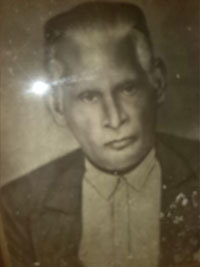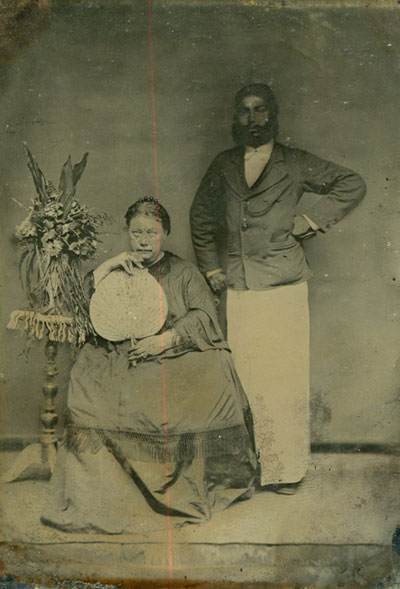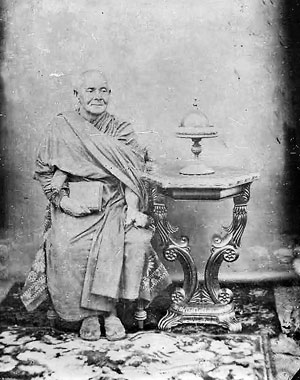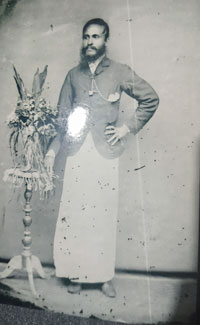75th Independence
Rare images in family photos
View(s):- Colonel Olcott and Madame Blavatsky’s historic visit to the island in 1880

P. B. Karolis
By Yomal Senerath-Yapa
It was in 2016 that Senaka Weeraratna’s mother Muriel passed on to her son a rusty old aluminum box found in their bungalow in Havelock Town.
Prising it open, there fell on the author cum lawyer’s lap some glass negatives and photos wrapped in brown paper.
Revealed were original and startling lost images from the late 19th century; photos taken by his great great grandfather (on the paternal side) Payagala Badalge Karolis, jeweller and pioneer photographer while pottering around a colonial Galle with his hefty apparatus capturing curious friends and family eager to be thus perpetuated through this ‘magic box’- and in the process unwittingly recording an epic meeting of East and West.
The most pivotal of the photos took Senaka to the year 1880.
Dated 18 May 1880, here was Madame Helena Blavatsky, with frowzy hair and hypnotic eyes boring through the film, seated majestically next to a handsome Sinhalese. That, says Senaka, must be Devendra Frederick de Silva, a veritable Croesus in Galle at the time, connected to his mother’s family.
Another photo of this same wealthy businessman shows him alone in manly poise when much older.

Madame Blavatsky with D. F. de Silva (also seen in bottom pic), May 1880
There is also a photo of the monk Ven. Bulathgamuwe Sri Sumanatissa Dharmalankara and one which Senaka strongly suspects to be Ven. Migettuwatte Gunananda (the champion of the Panadura Debates).
This trove of pictures, for Senaka, was an eye-opener: the role played by his own families (paternal and maternal) in the historic visit to Ceylon of Henry Steele Olcott and Madame Blavatsky in 1880.
D. F. de Silva was obviously a VIP when it came to the Theosophical Society (in fact he funded the reception of the American and Russian) as Madame Blavatsky would not otherwise have posed for a photo with him, says Senaka. Of note were also the two monks, as it was they who had invited the duo to the island.
P. B. Karolis also was part of the reception committee that welcomed the two.
The Colonel and Madame Blavatsky were taken ‘like princes’ through Galle and visited many an important house and temple.
That visit changed the fate and course of Ceylon history. Everyone was struck by the hypnotic powers of Madame Blavatsky, even the sceptical captain of the boat they took to the island.
The first night they stayed at Eliot Road in Galle, near No. 74 Wakwella Road where P. B. Karolis had his jewellery shop. Identified as the house of the Wijeratnes, it was where the groundwork for Olcott’s mission was discussed. The two families of Karolis and de Silva, had stayed Buddhist despite the lure of Christianity in colonial Ceylon.
D. F. de Silva, celebrated in that magnum opus 20th Century Impressions of Ceylon, had a house near the Colombo Museum and was drawn on a grand carriage. He also donated land to the Atapattana Vihara in Galle (a wooden wonder) and had a factory in Mahagalle (with 60 people) and shops including one in Chatham Street, Fort.
After his death in 1904, his wife, to remember him, gave Mahinda College Galle a hilltop land, Dawatagahawatta, for the Buddhist boys’ institution was ‘bursting at the seams’ and the principal F. L. Woodward wanted more space.
The next Weeraratna to shine forth – this time with direct missionary work – was Asoka, Senaka’s uncle who brought the family business to glittering heights by incorporating watches.

Ven. Bulathgamuwe Sri Sumanatissa Dharmalankara
He ran the shop near Ananda College with a staff of 60 and brought down a Swiss watchmaker who stayed for a year at the Grand Oriental Hotel and trained the staff of P. J. Weeraratna and Sons (as it was then) on watch repairing.
On a visit to Germany he was struck by the desolation of that country following the Second World War and was inspired to bring Buddhism to the people.
Thus began the German Dharmaduta Society. Asoka collected money and in 1957 bought “Das Buddhistische Haus” founded by Dr Paul Dahlke (now the Berlin Vihara). After founding the Meetirigala Nissarana Vanaya forest monastery in 1967, he himself took robes.
 The Colonel and the clairvoyant The importance of the visit to the island of Colonel Henry Steele Olcott and Madame Helena Blavatsky in 1880 cannot be overestimated; it meant the beginning of Buddhist English education (the Pettah English School or Ananda followed by so many others) and a veritable revolution that gave birth to Anagarika Dharmapala. Colonel Olcott and Madame Blavatsky took pansil in Vijayananda Pirivena, Galle on their first day in Ceylon. It is said that even the other members of the Theosophical Society were awed by Madame Blavatsky’s supernormal powers. Of Russian nobility, she was also a spirit medium. | |

